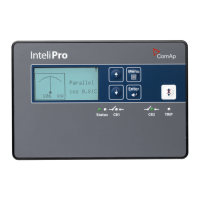InteliPro, SW version 1.0, ©ComAp – May 2011
InteliPro Application Guide
2-3
Introduction
InteliPro protection relay provides high range of flexibility to the users and their applications. In the
most common cases, one output for tripping is used. In this case, InteliPro allows provides the
common trip output, which represents logical "OR" of all activated and pre-set protective functions of
the unit. If needed, InteliPro also allows to operate two circuit breakers, where some protective
functions are assigned to one of them and other functions to the other. In such case, the circuit
breakers can provide backup for each other, so that in "fail to trip" situation the other circuit breaker
opens under pre-set conditions to clear the first breaker failure.
Furthermore, InteliPro provides two independent blocking inputs, which can be used to activate or
deactivate any of the protective functions of the unit. All necessary inputs and outputs can be freely
configured to any input or output of the unit. In case of outputs, any of the 2 relay outputs or 8 open-
collector outputs can be selected.
In case that any of the configured protective functions is activated, InteliPro relay provides a Trip
signal. This signal is provided in both positive and negative logic in order to follow the requirements of
the application:
• Due to increased safety requirements, some protective relays require that negative logic is
used, assuring that loss off power supply always causes the relay to trip. I.e. the relay
contacts are used, with fault-free position maintained in energized state. In case of power
supply fail, the unit goes to “fault” indication position. The outputs using negative logic are
marked with exclamation mark "!" as the first character of their name.
• In some applications, the negative logic is not a required functionality. The function of opening
the circuit breaker in case of loss of power supply is not accepted as a safety point and the
safety is assured by different means e.g. in the superior system or within the protection relays
intertripping scheme. In such case, the outputs with positive logic (without the exclamation
mark) can be used to signal the detected failure state.
In any case, it must be assured that the InteliPro relay has full control at opening the appropriate
breaker by the trip command - i.e. in case of Trip state the unit receives the appropriate CB
feedback, confirming its open position. The feedback must repond within preset time to the trip
command. A special attention should be paid to opening of motorized circuit breakers, as it could
take more than 2s on some types. In such cases it is necessary to use undervoltage coil for fast
opening.
Operation mode with 1 common trip output
• This is the essential mode of operation of the protection relay InteliPro. In this case, CB1
circuit breaker or contactor is considered as the main connection device, protected by
InteliPro. In the ComAp controllers, this breaker is called "Mains Circuit Breaker" = MCB.
• Second circuit breaker or contactor is not expected in the protection scheme, but there is still
possibility to use the "backup trip" signal from InteliPro relay to operate any backup device, if
present on the installation. As such device may be considered another circuit breaker in the
line of mains-connection, CB1 undervoltage coil, or any device which serves as a backup in
case of the CB1 fail.
• The Comm Trp (or !Comm Trp) output is used as the main signal to open the CB1 circuit
breaker. InteliPro expects that in such case, the CB1 Feedback input deactivates as a result of
the protection trip. Adjustable delay can be set by the setpoint General: BackupTrp Del, to
provide backup functionality for the CB1 breaker. If the feedback does not deactivate within
this delay, the output Bak Comm Trp activates (or !Bak Comm Trp deactivates) immediately.
• An function, which is activated and not blocked within the InteliPro unit activated the Comm
Trp signal. Use the blocking inputs to control which protective functions will be used under the
appropriate circumstances.

